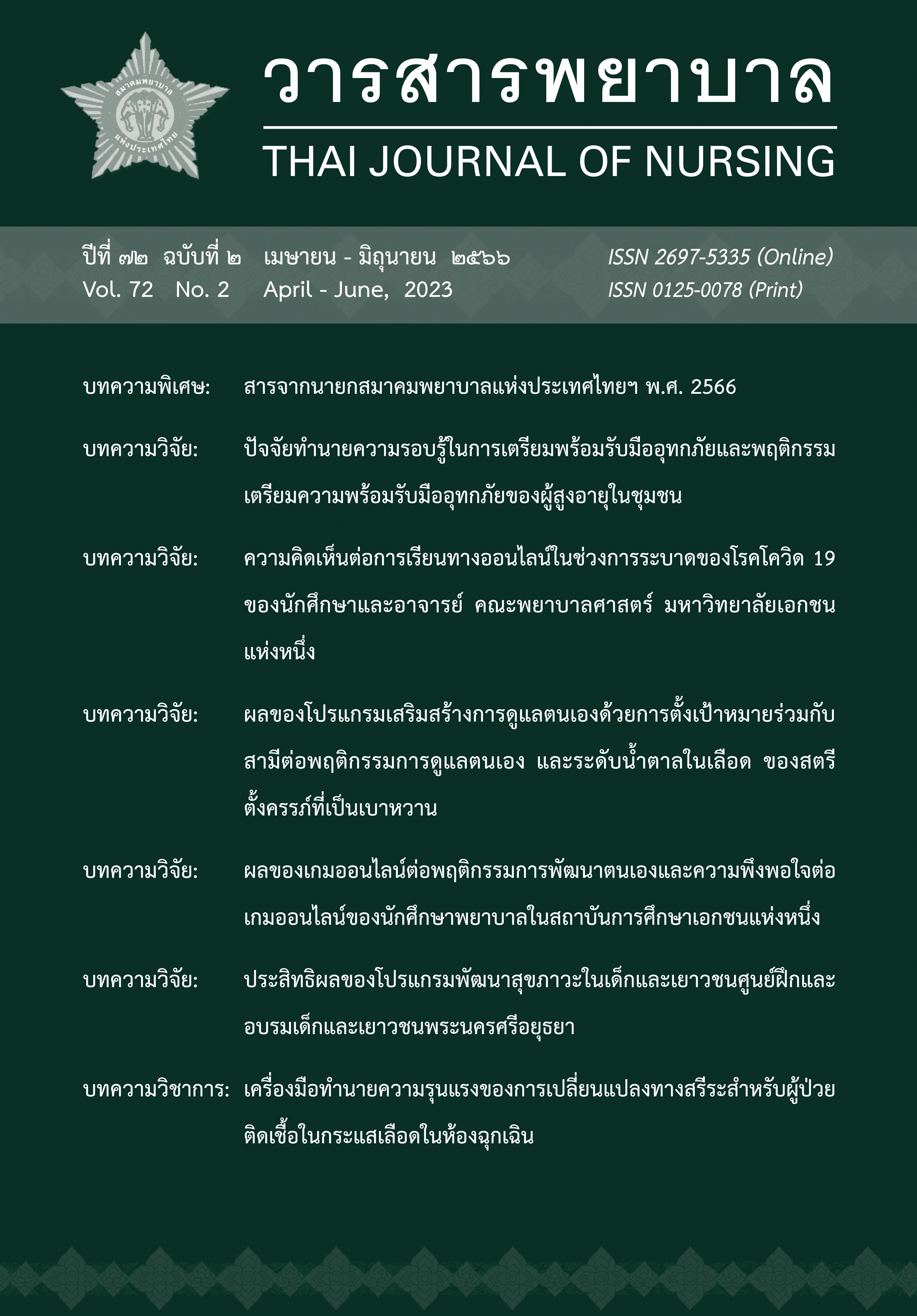Factors predicting flood preparedness literacy and flood preparedness behaviors among older adults in community
Main Article Content
Abstract
This descriptive research aims to find factors predicting flood preparedness literacy and flood preparedness behaviors among older adults in community. A sample of 138 older adults from 2 districts of one province in the North-Eastern Part of Thailand, was purposively selected. The research tools were Lawton Instrumental Activities of Daily Living Scale (I-IADL) in Thai, the questionnaires on flood preparedness literacy, flood preparedness behaviors and focus group discussion guideline. Data were analyzed by a stepwise multiple regression analysis and content analysis. The results are as follows. 1) Factors predicting flood preparedness literacy are age, instrumental activities of daily living, and number of underlying diseases. These three predictors accounted for 15.5%. 2) factors predicting flood preparedness behaviors are visual ability and family income. These two predictors accounted for 15%. 3) Family support, community leader and public health officials help older adults make well preparedness. However, the update information and housewares transport assistance are needed.
Article Details

This work is licensed under a Creative Commons Attribution-NonCommercial-NoDerivatives 4.0 International License.
References
กัณฐิมาภรณ์ บุญประกอบ. (2559). การเตรียมความพร้อมรับมือภัยพิบัติของชุมชนในพื้นที่ประสบอุทกภัย จังหวัดสุราษฎร์ธานี [วิทยานิพนธ์ปริญญามหาบัณฑิต ไม่ได้ตีพิมพ์]. มหาวิทยาลัยสงขลานครินทร์.
นารถลดา ขันธิกุล, อังคณา แซ่เจ็ง, ประยุทธ สุดาทิพย์, และ สุรเชษฐ์ อรุโณทอง. (2562). การเตรียมความพร้อมของผู้สูงอายุในการรับสถานการณ์ภาวะฉุกเฉินทางสาธารณสุขจากภัยพิบัติทางธรรมชาติ ในภาคเหนือประเทศไทย. วารสารสาธารณสุขล้านนา, 14(2), 1-12.
ปาณิศา บุณยรัตกลิน, สุภามาศ ผาติประจักษ์, และ นพวรรณ เปียซื่อ (2562). ความรอบรู้ในการเตรียมพร้อมรับมืออุทกภัยและพฤติกรรมการเตรียมพร้อมรับมืออุทกภัยของผู้สูงอายุในชุมชน [วิทยานิพนธ์ปริญญามหาบัณฑิต ไม่ได้ตีพิมพ์]. มหาวิทยาลัยมหิดล.
ปาณิศา บุณยรัตกลิน, สมจินดา ชมพูนุท, และ ศิริมล คัมภีร์พันธุ์. (2565). การสังเคราะห์ปัจจัยที่มีความสัมพันธ์กับความรอบรู้ในการเตรียมพร้อมรับมืออุทกภัย และพฤติกรรมของผู้สูงอายุในชุมชน. วารสารพยาบาล, 71(2), 38-47.
มุทิตา พนาสถิตย์. (2560). การศึกษาความตรงและความเที่ยงของแบบสอบถาม Lawton Instrumental Activities of Daily Living Scale (I-LADL) และ Older People’s Quality of Life Questionnaire (OPQOL-Brief) ฉบับภาษาไทย. โรงพยาบาลธรรมศาสตร์เฉลิมพระเกียรติ. doi: 10.13140/RG.2.2.27779.58407
มูลนิธิสถาบันวิจัยและพัฒนาผู้สูงอายุไทย. (2558). สถานการณ์ผู้สูงอายุไทย พ.ศ. 2557. อมรินทร์พริ้นติ้งแอนด์พับลิชชิ่ง.
วรรณเพ็ญ อินทร์แก้ว, และ สมจินดา ชมพูนุท. (2557). การพยาบาลสาธารณภัย. บียอนด์พับลิสซิ่ง.
Boonyaratkalin, P., Partiprajak, S., & Piaseu, N. (2021). Flood preparedness literacy and behaviors in community dwelling older adults. Disaster Medicine and Public Health Preparedness, 15(4), 452-457.
Brown, L., Haun, J., & Peterson, L. (2014). A proposed disaster literacy model. Disaster Medicine and Public Health Preparedness, 8(3), 267-275.
Cefalu, C. A. (Ed.). (2014). Disaster preparedness for seniors: A comprehensive guide for healthcare professionals. Springer.
Cox, K., & Kim, B. (2018). Race and income disparities in disaster preparedness in old age. Journal of Gerontological Social Work, 61(7), 719-734.
Mace, S. E., & Doyle, C. J. (2017). Patients with access and functional needs in a disaster. Southern Medical Journal, 110(8), 509-515.
Nutbeam, D. (2000). Health literacy as a public health goal: A challenge for contemporary health education and communication strategies into the 21st century. Health Promotion International, 15(3), 259-267.
Sri-On, J., Vanichkulbodee, A., Sinsuwan, N., Rojsaengroeng, R., Kamsom, A., & Liu, S. W. (2019). Disaster preparedness among Thai elderly emergency department patients: A survey of patients’ perspective. BMC Emergency Medicine, 19(1), 1-7.


